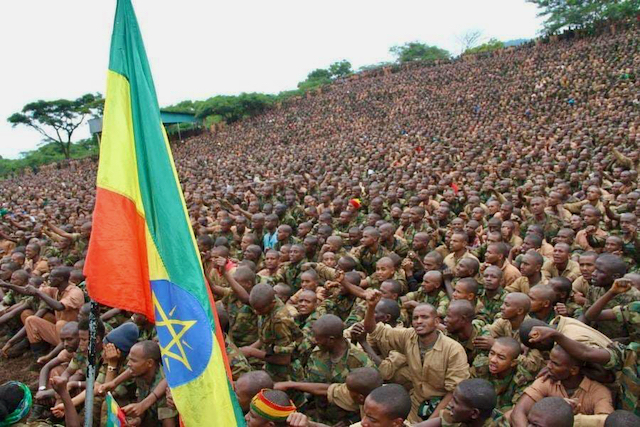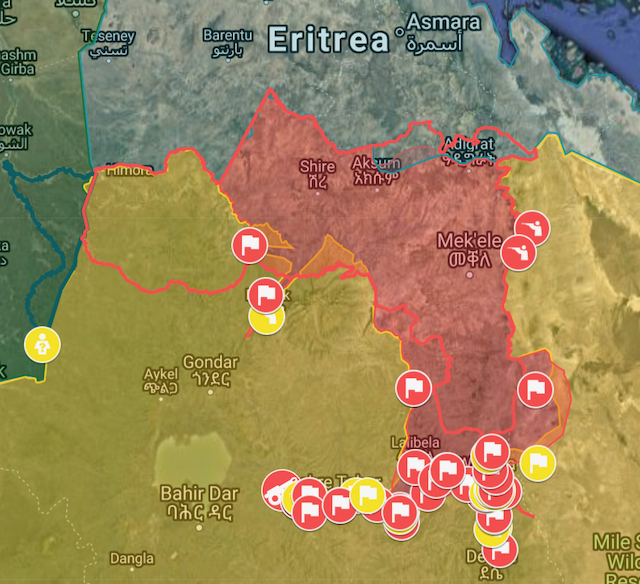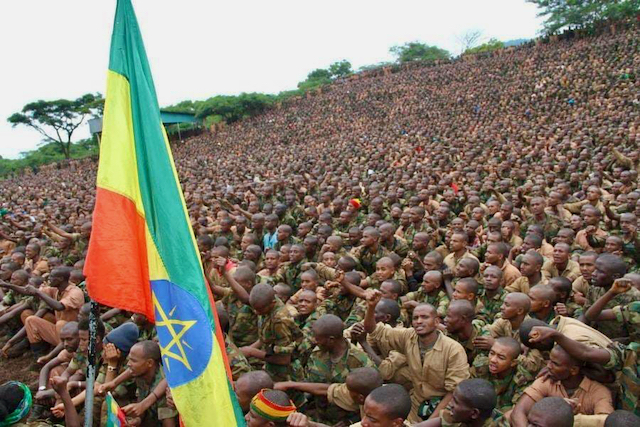
A decisive moment in the war in Tigray – a “best guess” at the outcome
Source: Martin Plaut
October 17, 2021
The Ethiopian government has blockaded the northern region of Tigray. This is a brutal attempt to starve the Tigrayan people into submission, as Mark Lowcock – the former head of the UN’s Humanitarian Affairs agency (OCHA) – made plain.
The region is also off limits to journalists – international and local – which makes attempting an assessment of the current state of the fighting very difficult. Having said this, it seems an appropriate moment to make a “best guess” at what is taking place.
Tigrayan claims
The commander of the Tigrayan army, issued a statement yesterday making a number of claims.
Tegadalay [freedom fighter] Tadesse Werede, has stated that the offensive started by invading forces of Abiy and his allies, which was accompanied by [war] planes and heavy artillery, has completely failed.The commander stated that out of the 34 divisions which the enemy deployed in the four fronts, 27 were involved in the fighting and that among these 70 to 80% were destroyed and scattered. Tegadalay Tadesse also announced that the [Chifra] front which they had bragged about saying “capturing Chifra is [as impossible] as surrendering Arat Kilo palace”; has been completely destroyed along with all its army which has made the enemy to completely lose hope while our army has acquired sufficient capability.
Tigray TV, 2 hrs ago, 16/10/21
Note: an Ethiopian division is theoretically 10,000 troops, but has shrunk to between 5,000 and 3,000 men.
Is this plausible?
The fourth phase of the Tigray war
It is possible to divide the war which began on the night of the 3rd/4th of November 2020 into four phases.
- Phase one: 4 November 2020 – 28 November 2020: the outbreak of the war until the Ethiopian troops captured the Tigrayan capital, Mekelle. Prime Minister Abiy announced that the city had fallen to his forces.
- Phase two: 28 November – 18 June 2021: The Tigrayans had been surviving and rebuilding their military in the region’s hills and mountains. On 18 June 2021 they went on the offensive. They launched what they called “Operation Alula Aba Nega,” or simply “Operation Alula.” In just ten days, from 18 June to 28 June 2021 the Tigrayans succeeded in sweeping all before them, until they marched back into Mekelle. As the Economist reported: “At sunset on June 28th—seven months to the day after Abiy Ahmed, Ethiopia’s prime minister, declared victory over the ruling party in Tigray as his troops occupied Mekelle—Tigrayans came onto the streets to celebrate the flight of federal troops. Officials appointed by Abiy’s government to run the region were whisked out of town as if from a crime scene. “There are celebrations in every house in Mekelle,” said Haile Kiros, a teacher in the city, before phone lines were cut.”
- Phase three: 18 June – present. Capturing Mekelle and expelling the invading forces from most of Tigray did not end the war. Tigray remained blockaded by both Eritrea and Ethiopia, with little outside food and humanitarian supplies reaching the region.

Large parts of western Tigray had long been claimed by their neighbours – the Amhara – and continued to be occupied by Amhara, Eritrean and Ethiopian troops, who were determined to prevent Tigray from establishing a route to Sudan, through which they could receive aid and other supplies.
As a result the Tigray Defence Forces (TDF) went on the offensive in two directions. They struck eastwards, to try to reach key roads in the Afar region and southwards, to reach key targets in the Amhara region.
The TDF was both successful and unsuccessful. The offensive in Afar was apparently halted by a major mobilisation of the Ethiopian military. The offensive in Amhara region was more successful, pushing deep into the region, but failed to reach cut the road from Gondar to Bahir Dar or capture the important town of Dessie.

Phase 4: Another phase of the war is under way.
Responding to the Tigrayan push southwards Prime Minister Abiy mobilised a large number of troops from ethnic militia.
They came from across Ethiopia, holding mass rallies at which young men (and some women) volunteered to fight for their country. Some were apparently conscripted into the military.
The end product saw an Ethiopian army that had been rebuilt after being decimated in the previous fighting. This left both sides with large number of troops at their disposal.
The table below provides a ‘best estimate’ of the rival alliances in early September 2021, although the troop numbers do not suggest that all soldiers are of equal ability or training. It must also be borne in mind that the Ethiopian and Eritrean forces have air forces and drones to draw upon.
| Opposition alliance | Ethiopian, Eritrean and other forces | |||
| Tigray Defence Forces (TDF) | 300,000 | Ethiopian National Defence Forces (ENDF) | 50,000 | |
| Oromo Liberation Army | 20,000 | Eritrean Defence Forces (EDF) | 300,000 | |
| Agew Liberation Army | 5,000 | Amhara Special Forces | 50,000 | |
| Afar | 3,000 | Fano + Amhara Militia | 200,000 | |
| Gumuz Liberation Front | 10,000 | Oromo Special Forces | 30,000 | |
| Gambella Liberation Army | 5,000 | Afar Special Forces | 10,000 | |
| Qimant Liberation Movement | 5,000 | Somali Special Forces | 5,000 | |
| Sidama National Liberation Front | 5,000 | Republican Guard | 3,000 | |
| Air force Commando | 3,000 |
The newly reconstructed Ethiopian military, together with their associated militia, (but apparently not their Eritrean allies) were thrown into the fray. The attack by vast number of essentially raw recruits was reminiscent of the “Red Star” campaign launched by the Ethiopian Derg in 1982 against the Eritrean liberation movement – the EPLF.
The Red Star campaign ended in disaster for the Ethiopian military.
The current state of the fighting
This question brings us back to the statement above by the Tigrayan army commander, Tadesse Werede. His claims appear to be supported by Amhara reports, particularly from around Wello.
It seems that the Ethiopians threw large numbers of poorly trained soldiers against objectives by using “human waves” in attempts to overrun the Tigrayan lines.

They were supported by more experienced units. The resulting casualties were apparently enormous.
This suggests that the TDF may be accurate in claiming that they have “destroyed” some 130,000 troops. By this they mean killed, wounded and scattered.
The key battles were around Gashena-Geregera where the ENDF attempted to cut off the Tigrayan units, only to be trapped in ferocious ambushes.

Futher battles took place around Chifra on the Tigrayan-Afar border.
Amhara sources claim that very large numbers of troops were involved. Tadesse makes only a brief reference to this fighting, suggesting that it may be ongoing.
There was also intense fighting for the Ambassel mountain range, near Wuchale. The outcome here is also less clear.
If the claims by Tadesse Werede are borne out and the Tigrayans can consolidate their positions, then the TDF will have made very considerable gains. The ethnic militia that Prime Minister Abiy recruited appears to have suffered very heavy losses.
Meanwhile, the Eritreans seem to be playing a relatively small role in the current fighting.
There are reports that President Isaias has maintained his forces along Ethiopia’s northern border, which runs along northern Tigray. Areas allocated to Eritrea by the International Boundary Commission have been held, but not much more.
There are suggestions that Eritrea has dug five lines of trenches to try to prevent the Tigrayans from advancing towards Asmara, once the fighting in the South is over.
Eritrean forces are also stationed in western Tigray, preventing the Tigrayans from establishing a supply line to Sudan.
All this would suggest that Phase Four of the Tigray war is not over, but the TDF have inflicted heavy losses on their Ethiopian opponents.
